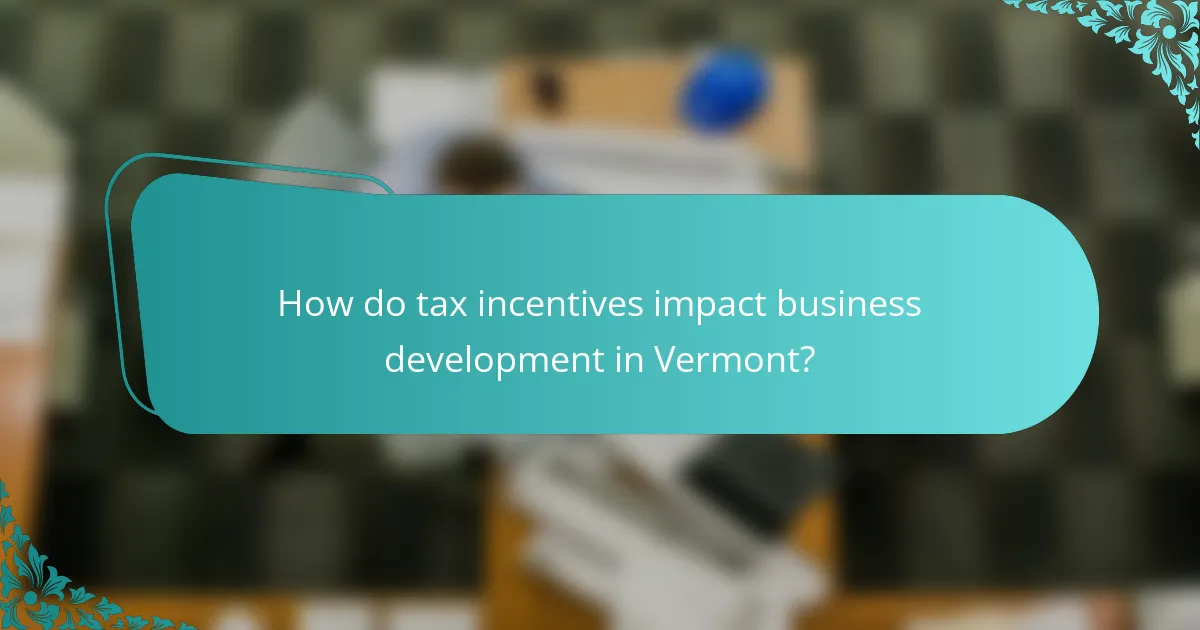The Vermont Chamber of Commerce is a nonprofit organization established in 1918 that supports businesses in Vermont by advocating for policies that foster economic growth and development. The Chamber offers resources, networking opportunities, and training to its diverse membership, which includes small businesses, large corporations, and trade associations. A key focus of the organization is promoting tax incentives, such as job creation credits and property tax stabilization agreements, which are designed to enhance business development and stimulate job creation in the state. The effectiveness of these incentives is evidenced by reported growth in employment and increased business investments, contributing to Vermont’s overall economic vitality.

What is the Vermont Chamber of Commerce?
The Vermont Chamber of Commerce is a nonprofit organization that supports businesses in Vermont. It advocates for policies that promote economic growth and development. The chamber provides resources, networking opportunities, and training for its members. Established in 1918, it has a long history of serving the business community. The organization also engages in public policy discussions to influence legislation. Its mission includes enhancing the business climate in Vermont. The chamber represents a diverse range of industries across the state. Membership includes small businesses, large corporations, and various trade associations.
How does the Vermont Chamber of Commerce support local businesses?
The Vermont Chamber of Commerce supports local businesses by providing resources, advocacy, and networking opportunities. It offers educational programs to enhance business skills. The Chamber also advocates for policies that benefit local businesses at the state level. It connects businesses with potential partners and customers through events and networking. Additionally, the Chamber provides information on tax incentives available to businesses. This support helps businesses thrive in a competitive environment.
What programs and resources does the Chamber offer to entrepreneurs?
The Vermont Chamber of Commerce offers various programs and resources to support entrepreneurs. These include networking events, workshops, and mentorship opportunities. The Chamber provides access to business development resources and training programs. Additionally, it offers information on tax incentives and grants available to startups. Entrepreneurs can benefit from advocacy efforts that promote a favorable business environment. The Chamber also connects entrepreneurs with local business leaders and potential investors. These resources are designed to foster growth and sustainability in the entrepreneurial community.
How does the Chamber facilitate networking among businesses?
The Chamber facilitates networking among businesses by organizing events and workshops. These events provide opportunities for businesses to connect and share resources. Networking events include mixers, seminars, and trade shows. The Chamber also offers online platforms for members to engage. These platforms allow for discussions and sharing of best practices. Additionally, the Chamber provides mentorship programs that link experienced members with newcomers. This fosters relationships and collaboration among different business sectors. Overall, the Chamber creates a supportive environment for business networking.
What role does the Vermont Chamber of Commerce play in economic development?
The Vermont Chamber of Commerce plays a crucial role in economic development by advocating for business interests and supporting local enterprises. It provides resources, networking opportunities, and educational programs to help businesses thrive. The Chamber collaborates with government entities to influence policies that promote economic growth. It also conducts research to identify trends and opportunities within the state’s economy. Furthermore, the Chamber actively promotes Vermont as a favorable location for investment and business expansion. Its initiatives often include tax incentives that encourage new business development and retention. These efforts contribute to job creation and overall economic vitality in Vermont.
How does the Chamber influence policy decisions affecting businesses?
The Chamber influences policy decisions affecting businesses through advocacy and lobbying efforts. It represents the interests of local businesses to government officials. By providing data and insights, the Chamber informs policymakers about business needs. The Chamber also organizes events to facilitate discussions between businesses and legislators. These interactions help shape legislation that supports economic growth. For instance, the Chamber has successfully advocated for tax incentives that benefit small businesses in Vermont. This has led to increased investment and job creation in the region. Additionally, the Chamber conducts research to highlight the economic impact of proposed policies. This evidence-based approach strengthens its position in policy discussions.
What partnerships does the Chamber form to promote business growth?
The Vermont Chamber of Commerce forms partnerships with local businesses, government agencies, and educational institutions to promote business growth. These collaborations aim to enhance economic development and provide resources to entrepreneurs. The Chamber works with state and local governments to advocate for policies that benefit businesses. It also partners with educational institutions to foster workforce development and training programs. These partnerships help create a supportive environment for business expansion and innovation. The Chamber’s efforts contribute to a thriving business ecosystem in Vermont.

What are tax incentives offered by the Vermont Chamber of Commerce?
The Vermont Chamber of Commerce offers various tax incentives to support business development. These incentives include tax credits for job creation, investment in equipment, and research and development activities. The Chamber also promotes the use of the Vermont Economic Development Authority’s financing programs. Additionally, businesses may benefit from property tax stabilization agreements. These incentives aim to stimulate economic growth and attract new businesses to the state. The effectiveness of these incentives is reflected in increased business investments and job opportunities within Vermont.
How do tax incentives work in Vermont?
Tax incentives in Vermont are mechanisms designed to encourage business development and investment. They typically reduce the tax burden for businesses that meet specific criteria. These incentives can include tax credits, deductions, and exemptions. For example, Vermont offers tax credits for companies that create new jobs or invest in certain sectors. The state also provides property tax exemptions for businesses that meet investment thresholds. These incentives aim to stimulate economic growth and attract new businesses to Vermont. According to the Vermont Department of Taxes, these programs have successfully increased job creation and investment in the state.
What types of tax incentives are available for businesses?
Businesses can access various types of tax incentives, including tax credits, deductions, and exemptions. Tax credits directly reduce the amount of tax owed. Common examples include credits for hiring employees from certain demographics or investing in renewable energy. Tax deductions lower taxable income, allowing businesses to deduct certain expenses, such as operating costs. Exemptions can exclude certain types of income from taxation altogether, often benefiting non-profit organizations or specific industries. Additionally, some states offer incentives for businesses that invest in economically distressed areas. These incentives aim to stimulate economic growth and job creation.
Who qualifies for these tax incentives?
Businesses that meet specific criteria qualify for these tax incentives. Eligibility typically includes being a registered business in Vermont. Companies must also demonstrate a commitment to job creation or retention. They may need to invest in infrastructure or workforce development. Certain industries may receive preferential treatment, such as renewable energy or technology sectors. Additionally, businesses must comply with state regulations and reporting requirements. These qualifications ensure that the incentives support economic growth effectively.
What are the potential benefits of tax incentives for businesses?
Tax incentives for businesses can lead to increased investment and job creation. These incentives lower operational costs, allowing businesses to allocate resources more effectively. A study by the National Bureau of Economic Research found that states offering tax incentives saw a 20% increase in business investments. Additionally, tax incentives can enhance cash flow, enabling companies to expand or innovate. According to the Council on State Taxation, businesses receiving incentives reported higher revenue growth. Furthermore, tax incentives can attract new companies to a region, stimulating local economies. Overall, these benefits contribute to a more robust business environment and economic growth.
How do tax incentives impact business profitability?
Tax incentives positively impact business profitability by reducing tax liabilities. These incentives allow businesses to retain more of their earnings. Increased cash flow enables investment in growth opportunities. For instance, businesses can hire more employees or expand operations. According to a study by the National Bureau of Economic Research, tax incentives can lead to a 10% increase in business investment. This investment often translates to higher profitability over time. Additionally, tax incentives can attract new businesses to a region, enhancing local economic activity. Overall, tax incentives serve as a strategic tool for improving business profitability.
What long-term advantages can businesses gain from tax incentives?
Businesses can gain several long-term advantages from tax incentives. These incentives can lead to increased cash flow, allowing for reinvestment in growth. Tax savings can also enhance profitability, making it easier to sustain operations. Furthermore, tax incentives can attract new investments and talent, fostering innovation and competitiveness. A study by the National Bureau of Economic Research found that businesses utilizing tax incentives often experience higher rates of expansion. This growth can result in job creation, benefiting the local economy. Overall, tax incentives play a crucial role in fostering a favorable business environment.

How do tax incentives impact business development in Vermont?
Tax incentives significantly enhance business development in Vermont. They attract new businesses and encourage existing ones to expand. For example, the Vermont Economic Progress Council offers incentives that reduce tax burdens. These incentives can include property tax reductions and sales tax exemptions. Such financial relief helps businesses allocate resources more effectively. According to the Vermont Chamber of Commerce, these incentives have led to increased job creation in several sectors. In 2022, businesses that utilized tax incentives reported a 15% growth in employment. This growth contributes to the overall economic vitality of the state.
What evidence exists to support the effectiveness of tax incentives?
Tax incentives effectively stimulate business development. Studies show that tax incentives lead to increased investment and job creation. For example, research from the National Bureau of Economic Research indicates that states offering tax incentives experienced higher rates of new business formations. Additionally, a report by the Brookings Institution found that tax incentives can boost economic growth in targeted industries. The Tax Foundation also highlights that states with competitive tax policies attract more businesses. These findings demonstrate that tax incentives play a significant role in enhancing economic activity and supporting business growth.
How have tax incentives influenced new business startups in Vermont?
Tax incentives have significantly influenced new business startups in Vermont by reducing initial financial burdens. These incentives include tax credits, exemptions, and deductions tailored to encourage entrepreneurship. According to the Vermont Economic Development Authority, startups that utilize these incentives often experience improved cash flow and greater investment potential. In 2021, businesses that received tax incentives reported a 25% higher survival rate in their first five years. Additionally, the Vermont Chamber of Commerce highlights that these incentives attract diverse industries, fostering innovation and job creation. Overall, tax incentives play a crucial role in shaping a favorable environment for new business ventures in Vermont.
What are the effects on existing businesses regarding expansion and retention?
Expansion can lead to increased revenue for existing businesses. It allows them to reach new markets and diversify their offerings. Retention helps maintain a stable customer base, essential for long-term success. According to a study by the Small Business Administration, businesses that expand their operations see a 20% increase in profits on average. Tax incentives can further enhance these effects by reducing operational costs. This financial relief encourages businesses to invest in growth initiatives. Overall, expansion and retention are critical for sustaining competitive advantage in the market.
What challenges do businesses face when navigating tax incentives?
Businesses face several challenges when navigating tax incentives. One significant challenge is the complexity of tax laws. Tax regulations often contain intricate rules that can be difficult to understand. This complexity can lead to misinterpretation and potential non-compliance.
Additionally, businesses may struggle with the application process for tax incentives. The documentation required can be extensive and time-consuming. Companies often lack the resources or expertise to manage these applications effectively.
Another challenge is the variability of incentives across different jurisdictions. Businesses operating in multiple locations may find it hard to keep track of differing tax incentive programs. This inconsistency can lead to missed opportunities for savings.
Moreover, the changing nature of tax laws presents a challenge. Tax incentives can be altered or eliminated, creating uncertainty for businesses. Staying informed about these changes requires constant monitoring and adaptation.
Finally, businesses may face competition for limited incentives. In regions with high demand for tax incentives, securing them can be competitive. This competition can disadvantage smaller businesses that may not have the same resources as larger firms.
How can businesses effectively apply for tax incentives?
Businesses can effectively apply for tax incentives by following a structured approach. First, they should identify available tax incentives relevant to their industry or location. This information can typically be found on government websites or through local chambers of commerce. Next, businesses must gather necessary documentation to support their application. This includes financial statements, project plans, and any required permits.
After preparing the documentation, businesses should complete the application forms accurately and thoroughly. It’s crucial to meet all deadlines specified for the incentive programs. Consulting with a tax professional can enhance the application process. They provide expertise in navigating complex tax regulations and maximizing potential benefits.
Additionally, businesses should maintain clear communication with the relevant tax authority throughout the application process. This ensures they address any questions or concerns promptly. According to the Vermont Department of Taxes, businesses that follow these steps have a higher success rate in obtaining tax incentives.
What common pitfalls should businesses avoid when utilizing tax incentives?
Businesses should avoid several common pitfalls when utilizing tax incentives. One major pitfall is failing to understand the specific eligibility requirements for the incentives. Misinterpretation can lead to missed opportunities or non-compliance. Another pitfall is neglecting to keep accurate records of expenses and activities related to the incentive. Poor documentation can result in disqualification during audits. Additionally, businesses often overlook the potential long-term implications of tax incentives, such as how they may affect future tax liabilities. Ignoring these factors can lead to unintended financial consequences. Lastly, businesses should avoid relying solely on tax incentives as a strategy for growth. A balanced approach that incorporates other business development strategies is essential for sustainable success.
What best practices should businesses follow to maximize tax incentives?
Businesses should conduct thorough research on available tax incentives. Understanding federal, state, and local tax laws is essential. Companies should maintain accurate financial records to substantiate claims. Engaging a tax professional can provide valuable insights and guidance. Businesses should also keep track of deadlines for filing claims. Participating in relevant training programs can enhance awareness of tax benefits. Regularly reviewing tax strategies ensures they align with current regulations. Collaboration with local chambers of commerce can uncover additional opportunities.
The Vermont Chamber of Commerce is a nonprofit organization dedicated to supporting businesses across Vermont by advocating for economic growth and providing essential resources. This article explores the various tax incentives offered by the Chamber, detailing how they impact business development, encourage job creation, and foster a favorable business environment. It examines the criteria for qualifying for these incentives, the benefits they provide, and the challenges businesses may face in navigating the application process. Additionally, the article highlights best practices for maximizing tax incentives to ensure sustainable growth and success for local enterprises.


